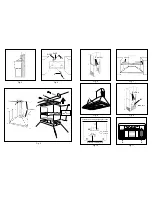
16
17
The use of an unprotected flame is
dangerous for the filters and could cause
fires.
Therefore, never use an open flame
under the hood. When frying foods, never
leave the pan alone because the cooking
oil could flare up.
— The hood must not be connected to fuel
exhaust flues (boilers, heating systems,
water heaters, etc.).
— Please, keep to the provisions of official
directives regarding the question of fume
discharge.
— The manufacturers refuse to accept any
responsibility for damage to the hood or
its catching on fire because of failure to
observe the above instructions.
Suggestions for the installation and
use of the hood
— The horizontal sections of the pipe must
be slanted slightly upwards (about 10%)
to ensure an easy flow of the air outwards.
— The best performance of the unit is
obtained in the external exhaust model
(suction), therefore in the limits of the
possibilities it is advised to use the
external exhaust (suction) type.
— The best performances are obtained with
short pipes (max. 4 m) and with few
curves.
Electric connection
Before completing any connection, make
sure the house voltage corresponds with
the voltage indicated on the label affixed
inside the hood.
The hood is supplied with a standard plug;
connect it to a correspondingly standard
socket. In the case is intended to connect
the appliance permanently to the mains
after having removed the plug supplied,
must be fitted a two-pole switch conforming
to regulations with an opening distance
between contacts of not less than 3mm.
The manufacturers are not liable for any
problems caused by the user’s failure to
observe the above instructions.
Fastening the hood to the wall
(Fig. 4)
— Position the template in the correct
position and make two 8mm diameter
holes and two 12mm diameter holes.
— Fit the two 8mm diameter plugs in the top
holes.
— Fasten the two hooks C in the bottom
holes.
— Hang the hood on the hooks and level it
with the screws D.
— Secure it in place with the two 5x45 mm
screws and 5-20 mm diameter washers
in the top holes. The screws and washers
are standard equipment.
Installing the duct for exhausting
version (Fig. 5-6)
— Fasten the top support E to the wall close
to the ceiling on the perpendicular of the
bottom connections. To do use the two
8mm diameter screws and plugs supplied
as standard equipment.
Insert the plastic mould P on the duct.
— Take the measure between the ceiling
and the hood top, and adjust the duct to
this height. Fasten it with screws F.
— Insert the duct with the slots downwards
and fasten it with the two top screws and
the two bottom screws G.
Installing the duct for recycling
version
Perform the same operations described in
the preceding paragraph. With screws
supplied, fasten the air conveyor M inside
the duct (Fig. 9).
Fastening of shelves (optional)
(Fig. 7)
Fasten the four side supports I to the adjacent
cabinets and place the shelf on the supports.
Operation
The hoods JDK 8420 and JDK 9420 are
provided with a motor with three speed.
For the best performance, we recommend
using the low speeds in normal conditions
and the high speeds in particular cases of
strong odour and vapour concentration.
We recommend starting up the hood a few
minutes before cooking and keeping it
running until all the odours have been
eliminated.
Maintenance
Before performing any maintenance
operation, disconnect the hood from the
electricity.
Grease filter
This serves to hold the grease particles in
suspension.
To remove the filter, push it towards
t h e b a c k o f t h e h o o d a n d p u l l i t
downwards (Fig. 8).
To clean, wash it in hot water and
biodegradable detergent or in a dishwasher.
Let dry before reinstalling.
Clean it at least once a month.
Carbon filter
This filter dissolves cooking odours.
It should be changed every 6-8 months in
normal use. Ask the technical assistance
service or manufacturing company for a
new one.
The carbon filter must never be washed.
To remove the carbon filter, push the push-
buttons B inwards and pull the filter
downwards (Fig. 2).
Important
Failure to observe the rules for cleaning the
appliance and changing and cleaning the
filters may cause fires.
Therefore, we recommend observing these
instructions.
Changing the neon light and starter
— Disconnect the hood from the electricity.
— Remove the light covers L by unscrewing
the fixing screws (Fig. 8).
— Replace the damaged lamp with one of
equal rating (40W-max. E14).
— Before calling for technical service
because the light fails to work, make
sure the lamps are well screwed.
Cleaning
To clean the outside of the hood use a cloth
moistened with denatured alcohol or neutral
liquid detergents. Never use products
containing abrasive.
This appliance meets 87/308 EWG radio
and television noise Standards






















